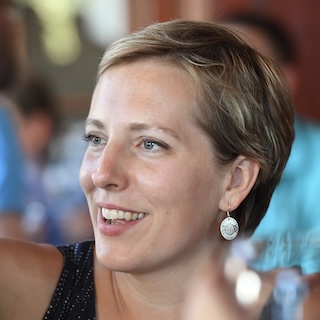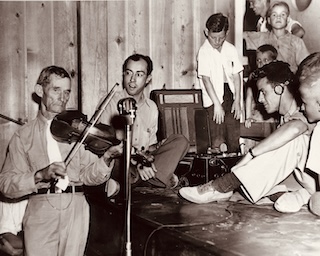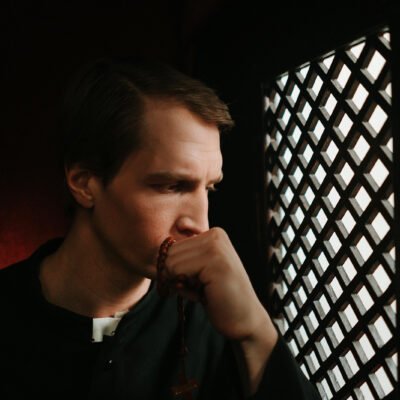A Conversation with Sonja Czarnecki

“In order to understand history, you have to do history,” Sonja Czarnecki insists. “You need to see how historical narratives are made.” To give students insight into the work of historians, Czarnecki assigns research projects in all of the courses she teaches at Bishop Seabury Academy in Lawrence, Kansas. She also pursues her own research. In October, Czarnecki’s article “Migrant Music” was published in The Chronicles of Oklahoma. Czarnecki, a 2022 graduate of the Master of Arts in American History and Government program, wrote the paper for a “Great Texts” course taught by Professor Stephen Tootle on John Steinbeck’s The Grapes of Wrath.
Probing the Historical Portrait of Migrant Farmworkers
Czarnecki’s article examines the popular portrait of midwestern farmworkers who migrated to California in the 1930s, a portrait drawn by historians, folklore collectors, and Steinbeck’s novel. She focuses on two amateur folklorists from New York who traveled to migrant farmworker camps during the Great Depression to record what they considered the “authentic” folk music of Oklahoma, Missouri, Arkansas and Kentucky. In fleeing the dustbowl conditions of the Midwest, the migrants had “left behind many of their material possessions,” Czarnecki writes, but the folklore collectors “reasoned that they brought instead an intangible cultural heritage in their stories and songs.” Hence the collectors brought rather specific expectations to their encounters with migrant musicians.
In 1940, Charles Todd and Robert Sonkin visited seven Farm Security Administration camps in California’s Imperial Valley, carrying along recording equipment provided by celebrated folklorist Alan Lomax. Lomax hoped the young men would bring back audio documents for the Archive of American Folk Song at the Library of Congress. The migrants Todd and Sonkin met were happy to sing, some hoping to be “discovered” for careers in radio. At first, they sang popular commercial tunes or the white gospel songs heard on religious programs. Todd and Sonkin found it necessary to explain to the migrants what sort of songs they were looking for. Czarnecki writes,
Todd carefully filtered the selection of songs for recording. Material that failed to distinguish the Okies as unique, or that did not fit Todd’s notion of ‘folk,’ usually did not make the cut. In this way, Todd and Sonkin reinforced the stereotype of the Okies as country bumpkins, making them seem far less connected to mainstream American culture than they actually were.

The folklorists’ work “had the insidious effect of exaggerating regional and racial differences” among Americans, Czarnecki added, even as the radio and record industries were blurring those differences, giving Americans common cultural referents.
Preparing to write the paper, Czarnecki listened to “hundreds” of migrant song recordings available at the Library of Congress website, also reading notes Todd and Sonkin made about the migrants who performed them, letters between Todd and Lomax, and scholarly articles on the emergence of folk music as an American genre. “I had a blast. I cranked it out over Thanksgiving break, and then I thought, ‘Maybe I should try publishing it.’” After sending the essay to the Chronicles of Oklahoma in late 2022, she forgot about it. Then, last June, while attending the National History Day Contest with a student of hers who was competing, she saw on her iPhone the email announcing the article had been accepted. “I felt like I’d won my own History Day contest!” Czarnecki says. Then she muses, “More graduate students should submit their research papers, because you never know.”
Research Empowers Students of History
Research work benefits everyone, Czarnecki feels. At Bishop Seabury, a small independent school in the Episcopal tradition, high school students take two or more of Czarnecki’s courses. She asks freshmen taking World History and juniors taking US History to complete a large independent research project. They must follow the guidelines set for the National History Day competition, although they may choose whether or not to enter the contest. “Most kids find a topic that they care about,” Czarnecki says. Recently, students have investigated the invention of radar, the impact of the bicycle on early feminism, and the Russian Civil War.
Since all of the projects must incorporate primary sources, students learn how to access online archives such as the Hathi Trust and newspapers.org. Czarnecki watches students display confidence and a sense of “authority” over the topics they’ve researched as they explain their work to others. Older students interview the freshmen, and all those competing in National History Day are interviewed at the district level by parent volunteers. Having crafted their own historical narratives, students also feel empowered to evaluate the work of professional historians more critically.
High school students are not “too young” to probe historians’ methods, Czarnecki said, given what’s at stake. “Who gets to construct truth? How do historians come to know what they think they know—and are they right? You know, history only became interesting to me when I realized that historians disagree with each other!” Historical narratives, Czarnecki tells her students, always reflect “the concerns of the writers, their reading, their hopes and ideologies. All this affects what gets reported and what doesn’t. It shapes the stories we Americans tell about our past—and who we believe we are.” Czarnecki mentions the “Lost Cause” narrative of the Civil War. Despite losing the war, “the South won the story” during much of the following century, delaying a reckoning with racial injustices that persisted long past emancipation.
Why Historical Narratives Conflict
Conflicting narratives of American history arise inevitably from Americans’ ongoing debate over which political principles should take precedence in civil life. A careful reading of the Constitution reveals what American democracy “looks like structurally.” But it is harder to define and enumerate “the characteristics of civil society” in America. Early in Czarnecki’s senior-level Politics and Government course, students do a gallery walk, studying fourteen signs Czarnecki posts around the classroom. Each describes some component of democracy, such as free and open elections, freedom of the press, transparency in government, economic freedom, an independent judiciary, and so on. Students then attempt to rank these components in priority order.
Their study of US History as juniors has already made them aware of “internal contradictions among all these democratic principles.” In her US history course, Czarnecki uses scenarios developed by the Harvard Case Method Institute to get students probing these tensions. For example, one case study puts students in the position of delegates to the Constitutional Convention, debating Madison’s proposal for a federal negative over state laws. The debate touches on the tension between majoritarianism and individual liberty, Czarnecki says.
How MAHG Expanded Czarnecki’s Teaching
Czarnecki’s MAHG studies more than prepared her to take on such questions. For eleven years, while serving as Dean of Students at Bishop Seabury, she taught world history. Completing the MAHG program, she stepped down from her role as Dean so as to also teach courses in US history and government. “I was raring to go! After getting exposed to the huge variety of materials we read and discussed, I felt almost too prepared. While I haven’t had time to process and filter into my teaching everything I was exposed to, some primary documents I learned about through MAHG have become essential texts.” She mentions Lincoln’s Fragment on the Constitution and the Union, which compares the Declaration’s principle of human equality to a painted “apple of gold” and the Constitution to a “frame of silver” that highlights and preserves equality. Asked how students react to Lincoln’s analogy, she gestures, her hand moving outward from her head like an expanding insight. “It’s amazing, really beautiful,” she says.
Now she sees herself preparing students for lives of civic engagement. Along with teaching research methods and critical thinking, she makes opportunities for students to meet and talk with civic leaders in both political and nonpartisan positions. “Kansas is small enough that I could invite former governor and Director of Health and Human Services Kathleen Sebelius to visit my class two weeks ago.” Through the League of Women Voters (she is president of her local chapter), she organized a panel of City Commissioner candidates who took her students’ questions. “In Lawrence, our city commission race is non-partisan. It’s important for students to see leaders debating issues without the screen of politics.”
All of the resources Czarnecki brings to her teaching—primary documents, research opportunities, encounters with current leaders—prepare students to participate in the ongoing dialogue of democracy.


